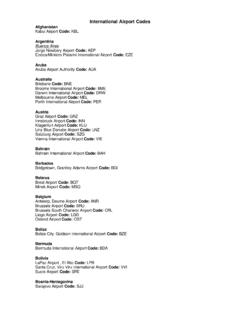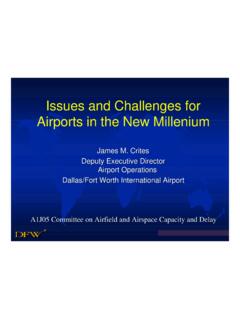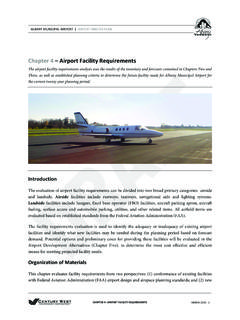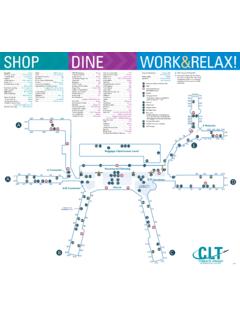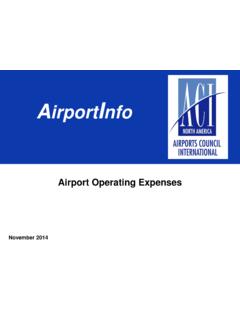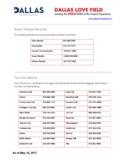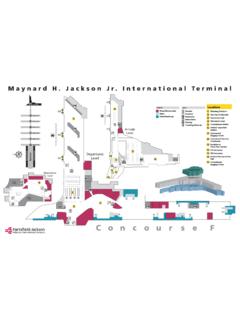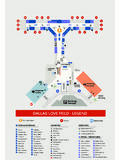Transcription of Airport Economic Development Model - EDR Group
1 Paper presented at the PTRC International Transport Conference, Manchester, England, AREA Economic Development MODELGlen E. Weisbrod, Economic Development Research Group , Boston, MAJohn S. Reed and Roanne M. Neuwirth, Cambridge Systematics, INTRODUCTON AND OVERVIEWAs business markets become national and international in scale, airports are increasingly beingviewed as catalysts for local Economic Development . Their ability to generate jobs and attractnew business is being used in many locations as a justification for public investments in newairport construction and expansion. Anticipation of new business activity also calls forappropriate land planning. Yet few types of Economic Development have been as poorlypredicted as Development around airports. At some airports, large tracts of surrounding landreserved for Development have remained vacant for decades.
2 Unforeseen rapid developmentaround other airports has saturated the area and choked area roads with traffic. In some cases, thearea around a new Airport has had both situations occur over a period of 25 paper is intended to help explain these situations by providing a framework forunderstanding Economic impacts and planning for Development around new or expandedairports. It is based on studies by Cambridge Systematics of airports in Europe, Japan and NorthAmerica. Based on the experience in the vicinity of these airports, we have constructed a modelsystem for forecasting Economic impact and planning for Airport area land Development . Themodel divides impacts in terms of Airport facility employment, directly-related business activity,businesses attracted to the surrounding area and spin-off Development . This paper describes thebasic framework for identifying the nature of Economic activities occurring in each of theseareas, the variable factors affecting their magnitude, and applications of the Model system forairport-related planning.
3 Commercial airports are emphasized here, but general aviation airportsare also GEOGRAPHIC LOCATION OF BUSINESS RELATIVE TO AIRPORTWe can define four categories of location relative to airports: (I) at Airport , (2) adjacent to theairport, (3) vicinity of the Airport or along a corridor easily accessible to the Airport , and (4)elsewhere in the metropolitan area or region. Each has different characteristics of Airport -relatedbusiness and different timing of Development . We can relate these characteristics to explanatoryfactors including Airport requirements, the regional economy, local transportation access andland At the AirportAirport employment depends on the volume of aviation activity at an Airport , which isdetermined not only by the population of the region it serves, but also by the Airport 's airservice function. The number of commercial flights and the mix of locations served by themdefines whether the Airport functions as an: (1) intercontinental gateway, (2) international (samecontinent) gateway, (3) regional transfer hub, (4) local origin/destination point, (5) specializedair cargo distribution centre, or (6) overnight parcel hub.
4 As a result, the ratio of annual airportpassengers to regional population (for N. America and W. Europe) ranges from as high as Charlotte, NC, USA (a regional hub Airport ) to as low as for Cologne, Germany (a localorigin/destination Airport ). The ratio is much lower for developing associated with Airport operations includes the airlines, aircraft support services,passenger services (including restaurants, shops and desks for car rental and ground transport),air freight services and government activities (including immigration). The correlation betweenpassenger volume and Airport employment is illustrated in Figure Adjacent to the AirportActivities immediately adjacent to commercial airports typically include: services directly supporting operation of the Airport (flight kitchens, aircraft maintenanceservices), services for airline employees and passengers (hotels, restaurants and additional car rentalfacilities), and Airport -related freight services (shipping, freight forwarding, customs and sometimes aforeign trade zone).
5 These types of activities are often located on adjacent land reserved for such uses. Theytypically start within a year of Airport opening. For each of these three types of activities, theemployment level is directly proportional to the corresponding magnitude of the airportfunction as an aircraft servicing centre, a passenger flight endpoint, or a freight origin Vicinity of the Airuort and Airuort Access CorridorIn most cities, we have found that the greatest concentration of business activity around anairport is within 6 km of the Airport , or along an access corridor within 15 minutes of theairport. Development in these areas are either spin-off industries or attracted industries include petrol filling stations, lodging and housing for Airport workers,and retail serving them. These activities grow directly with Airport activity levels, althoughthey often take 5 to 10 years after Airport opening to fully businesses are businesses that do not rely directly on the Airport for theiroperation, but which value location near an Airport because of its prestige, air services andbr accessibilitv of location for visiting customers and employees coming by air.
6 There aresome similarities, but also significant differences, in the overall mix of business activityattracted to the areas surrounding specific airports. Detailed profiles of all businesseslocated within 6 km of airports were compiled by the authors. In common among airportswere high concentrations of air transport services, freight forwarding, warehousing andhigh-tech oriented businesses with products having a high value-to-weight ratio ( ,electronics, optics and measuring instruments). Figure 2 contrasts the mix of businesses inthe areas surrounding three airports. It shows relatively constant proportions ofemployment in transport and warehousing activities, but wide variation in the relativelevels of manufacturing and service industries. These differences can be explained bydifferences in the regional economy and Airport location, as discussed later in Section empirical studies of US airports by the authors have shown that employmentgrowth within 6 km of airports can be two to five times faster than in the suburban ring ofthe metropolitan area in which they are located.
7 From that data, we can classify businessactivities by the extent to which they are disproportionately attracted to, and concentratedin, the vicinity of airports. These findings are summarised in Table attraction of business activity and land Development to the vicinity of airports may take5 to 20 years (or more) to develop. The timing and magnitude depend not only on airportand air service attributes, but also on factors of local access, metropolitan economiccharacteristics and land Development patterns (discussed later in this paper). Elsewhere in the Metropolitan AreaNew or expanded airports can have several different types of effects on business activity inthe rest of the metropolitan area or region, each of which must be appropriately handled inany accounting of overall regional Some business activities may shift away from elsewhere in the metropolitan area torelocate in the Airport vicinity.
8 This represents neither net growth nor net loss for theregion as a whole. Some businesses may be attracted to locate in the metropolitan area, but notspecifically in the Airport vicinity, because of the improved quality of life and upgradedair service for the region. It is overstatement to attribute this Economic growth solely tothe Airport , as it is but one contributing factor among many affecting such businesslocations. Some business growth occurs elsewhere in the metropolitan area as an indirect effectof net regional growth in Airport -related businesses, as those businesses in turn increasedemand for other local goods and services supplied to them. Other business growthoccurs as an induced effect of the additional consumer spending by workers hired atairport-related businesses and their Economic MARKET ORIENTATION OF ATTRACTED BUSINESSESIn general, we can identify business activities attracted to Airport areas as either newactivities attracted to the area or expansion of existing activities of a type already occurringin the metropolitan Activities may be attracted from outside of the area because of the prestige andimproved customer access provided by enhanced national and international air service Forlarge commercial airports, these new activities may include: (a) regional or nationalcorporate headquarters of large national and multi-national companies; (b) trade andmerchandise centres marketing retail or industrial products.
9 (c) service companies that aredependent on air service to reach their markets; and/or (d) airlines and related of activities in the metropolitan area occur for types of businesses that are usersof Airport services, suppliers to markets generated by the Airport , or businesses that can takeadvantage of the local transport and other supporting infrastructure developed primarily toserve the Airport . These are typically: (a) high-tech electronics and specialised equipmentmanufacturers, (b) communications companies, (c) warehouse and delivery services, and(d) a variety of specialised business specific situations, specialisation of the regional economy or specialisation of the airportmay also attract business activities concentrated in other categories, such as: membershiporganization headquarters (near Washington/Dulles Airport ) or exporters (in Amsterdamand Paris).
10 Hotel and convention facilities are another rapidly expanding type of business. Themagnitude of these developments is not closely related to the passenger volume of airportactivity. The ratio of hotel rooms (within 6 km of the Airport ) per thousand airportpassengers (annually) ranges in Europe from .06 (Paris/Orly) to .13 (London/Gatwick),2while in North America it ranges from .10 (Dallas/Ft. Worth) to .21 (Chicago/OHare). Thesupportable number of hotel rooms is predictable based on four factors: (1) extent of hubversus destination travel, (2) Airport location relative to office activity centres, (3) hotelagglomeration at conference centres, and (4) land use is yet another rapidly growing type of business activity. Shopping facilities are beingexpanded and upgraded at many airports. Airport vicinity shopping centres are alsoincreasing, following nearby population CRITICAL FACTORS AFFECTING BUSINESS ATTRACTION AND LANDDEVELOPMENTT here are three key factors that affect the timing, magnitude and character of airportvicinity land Development .


